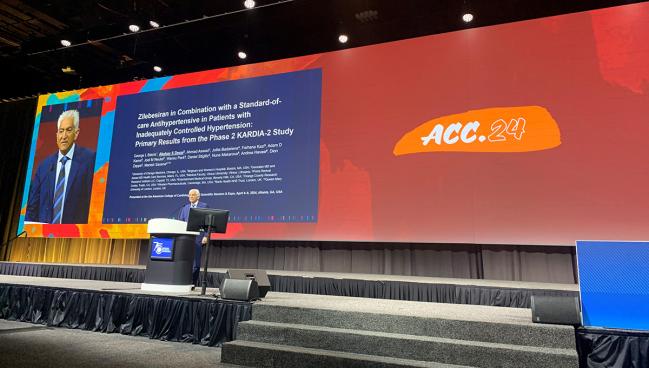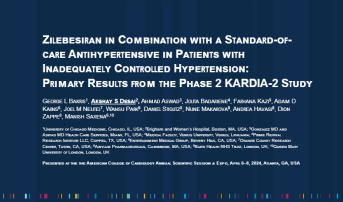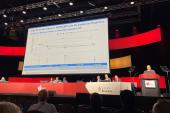KARDIA-2: Zilebesiran Drops BP on Top of Common Antihypertensives
Effects were more marked for patients already taking a diuretic or calcium channel blocker, but less so on top of a potent ARB.

ATLANTA, GA—Evidence continues to grow for zilebesiran, the investigational, twice-yearly injection that blocks production of angiotensinogen.
Results of the phase II KARDIA-2 trial, presented earlier this week at the American College of Cardiology (ACC) 2024 Scientific Session, showed that a single subcutaneous injection reduced systolic blood pressure (SBP) between 4 and 12 mm Hg at 3 months, when taken on top of one of three different medication classes.
The trial was conducted in patients whose blood pressure was uncontrolled by one or more drugs at study onset, who then went through a washout period before randomization to indapamide, amlodipine, or olmesartan, plus either the investigational drug or a placebo injection. While additional BP-lowering agents could be added back at the 3-month mark if blood pressure remained uncontrolled, the trial showed that systolic blood pressure levels remained lower in patients taking zilebesiran than in those randomized to placebo.
“Treatment with a single, subcutaneous dose of zilebesiran 600 mg was associated with clinically significant reductions in 24-hour mean ambulatory and office SBP compared with placebo at month 3 when added to a diuretic, [calcium channel blocker], or maximum-dose ARB,” said Akshay Desai, MD (Brigham and Women’s Hospital, Boston, MA), who presented the results here. “These differences were sustained to month 6 in the indapamide and amlodipine cohorts despite add-on antihypertensive therapy.”
While long-term safety still needs to be established, “these results support the potential for combining biannual dosing of zilebesiran with standard-of-care antihypertensives to achieve additive blood pressure reductions,” he said.
Zilebesiran works by interfering with messenger RNA to stop the production of angiotensinogen, which sits at the top of the renin-angiotensin-aldosterone system (RAAS). Blocking it has the potential to impact the body’s blood pressure regulation downstream. These current results build on the positive findings of the KARDIA-1 trial, previously reported by TCTMD, which tested the drug in patients not taking any other BP-lowering drugs. Another phase II study, KARDIA-3, is now underway looking at patients whose hypertension remains uncontrolled by two to four standard-of-care antihypertensives who have high cardiovascular risk or advanced chronic kidney disease, Desai said.
Key Findings
KARDIA-2 investigators enrolled 672 patients (mean age 59; 57% male) taking one of the three once-daily medications, each representing a different class of commonly used drug classes, and then randomized them to a one-time dose of either zilebesiran or placebo.
At 3 months, each of the groups assigned to the study drug saw statistically significant drops compared to the BP changes in the placebo group, but these ranged in magnitude from 12 mm Hg in those taking indapamide to 9.7 mm Hg in those on amlodipine to just 4 mm Hg in those taking olmesartan. Even after additional agents were added at the 3-month mark, as noted, patients in the zilebesiran group still had an edge in terms of BP-lowering.
Speaking with TCTMD, Wanpen Vongpatanasin, MD (UT Southwestern Medical Center, Dallas, TX), said she’s been following the zilebesiran trials and thought the KARDIA-2 results were “quite promising,” adding that she thought patients would welcome a medication that didn’t need to be taken daily. Other areas of medicine such as hyperlipidemia and osteoporosis, she added, have demonstrated that an injectable administered in the doctor’s office at protracted intervals appeals to patients. “I think this could be very, very attractive for people who have difficulty taking pills.”
It remains to be seen just how beneficial this agent would be on top of agents already working within the angiotensin pathway, as indicated by the blunted effect in patients taking olmesartan, she cautioned. “This drug is working through angiotensinogen which eventually is converted to angiotensin II, and by working through this inhibition, it's causing lowering of blood pressure. But with a medication like olmesartan, which already is very effective in blocking this pathway, when this drug was put on top of it, the effect is much, much more modest,” she said. The previous KARDIA trial showed a similar finding, she added.
Vongpatanasin, who is the clinical chair for the American Heart Association’s upcoming Hypertension meeting, says she will be on the lookout for how the agent performs in settings where blood pressure measurement may not be as stringent as in a tightly controlled study. Patients exhibiting white coat hypertension, for example, might get prescribed an agent like this, increasing the risk for hypotension that cannot be as easily reversed with an RNA interference therapeutic.
For example, she said, “how long does it take for that to turn off? And . . . when we start to use it more in a diverse population where blood pressure measurement is not as precise, we could potentially see more hypotension, more acute kidney injury.”
Desai addressed some of these concerns during an ACC “Deep Dive” session following the late-breaker, noting that an antidote to zilebesiran is in the works. In the meantime, “I think that we have some reassurance in the safety data accumulated so far that serious hypotension hasn't happened,” he said, acknowledging that the follow-up so far has not been sufficient to make strong statements on durable safety.
“The reassurance that I can provide at this point is that we did see, in the phase I experience, salt responsiveness to rescue the blood pressure-lowering effect of zilebesiran; volume resuscitation is also effective,” he said. “And because we are antagonizing only one key axis for blood pressure support, it stands to reason that pressors that agonize other axes that are important in blood pressure control, [such as] sympathomimetics, should still be effective.” Preclinical studies also point to the potential reversal effects of direct infusion of angiotensin II.
“We think apart from the reversal agent program that . . . is under development, there are reasons to believe that we should be able to maintain rescue strategies for hypotension,” Desai said.
Shelley Wood is the Editor-in-Chief of TCTMD and the Editorial Director at CRF. She did her undergraduate degree at McGill…
Read Full BioSources
Desai AS. Zilebesiran in combination with a standard-of-care antihypertensive in patients with inadequately controlled hypertension: primary results from the phase 2 KARDIA-2 study. Presented at: ACC 2024. April 7, 2024. Atlanta, GA.
Disclosures
- The study was funded by Alnylam Pharmaceuticals, the manufacturer of zilebesiran.
- Desai reports receiving consulting fees/honoraria from Abbott Laboratories, Alnylam, AstraZeneca Pharmaceuticals, Avidity Biopharma, Axon Therapeutics, BioFourmis, Cytokinetics, GlaxoSmithKline, Medpace, Merck, NewAmsterdam, Novartis Corporation, Parexel, Regeneron, Roche, scPharmaceuticals, and Verily; being an adjudicator for clinical endpoint committees for the Baim Clinical Research Institute and the TIMI Study Group; and receiving research grants from Alnylam, AstraZeneca Pharmaceuticals, Bayer Healthcare Pharmaceuticals, Novartis Corporation, and Pfizer.
- Vongpatanasin reports no relevant disclosures.





Comments